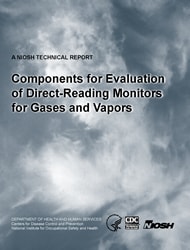Components for Evaluation of Direct-Reading Monitors for Gases and Vapors
July 2012
DHHS (NIOSH) Publication Number 2012-162

The Occupational Safety and Health Act of 1970 (Public Law 91–596) charged the National Institute for Occupational Safety and Health (NIOSH) with the responsibility for the development and evaluation of sampling and analytical methods for workplace compliance determinations. Under that charge, NIOSH and the Occupational Safety and Health Administration jointly undertook the evaluation of sampling and analytical methods for airborne contaminants by contract in 1974 to determine if methods met the criterion to produce a result falling within 25% of the true concentration 95 times out of 100. The present document further expands the experiments used during the initial methods development and evaluation research to direct-reading monitors for gases and vapors.
This document provides discussion of the physical, operational, and performance characteristics for direct-reading monitors. Guidance is provided for experiments to evaluate response time, calibration, stability, range, limit of measurement, impact of environmental effects, interferences, and reliability of direct-reading monitors. Also included are evaluation criteria for the experiments and details for the calculation of bias, precision and accuracy, and monitor uncertainty.
Components for Evaluation of Direct-Reading Monitors for Gases and Vapors [PDF – 3835 KB]
